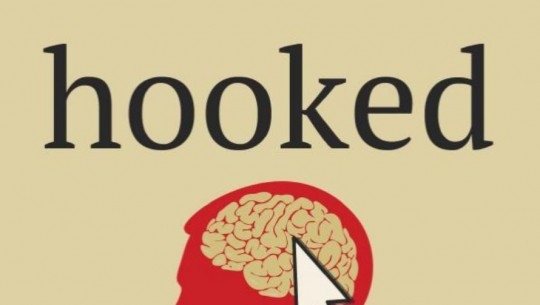Hooked by Nir Eyal
Book Review: Hooked: A Guide to Building Habit-Forming Products by Nir Eyal and Ryan Hoover

Were you surprised when Facebook acquired Instagram for $1 billion? Stunned by their $19 billion Whatapp deal? Both of these companies were young and had questionable revenue streams. What they did have, in each case, were stunningly large numbers of frequent users.
How did these companies, along with others like Pinterest and even Facebook itself, achieve such tremendous growth and stickiness? How did Facebook supplant more established competitors like MySpace and Friendster? Nir Eyal, author of Hooked: A Guide to Building Habit-Forming Products, has the answer: these firms created products with habit forming, even addictive, characteristics.
Eyal proposes “The Hook Model” as a design approach for designing habit-forming products. This model, which builds on BJ Fogg’s Behavior Model, is a circular process that, if done right, becomes self-reinforcing.

Everything begins with a trigger – an email, perhaps, or an advertisement. It could be an invitation from a friend. The trigger changes over time. After the initial one, other external triggers may follow – email reminders, mobile notifications, etc. Eventually, the triggers become internal to the user… “I’m bored, so I’ll check Pinterest…”
The action phase must be as simple and easy as possible. Social logins, for example, eliminate registration forms and double-opt-in email confirmations. Simplicity is critically important. Photo editors and sharing tools have been around for many years, but Instagram made the process so easy that a new user doesn’t need instructions. Try that in Photoshop!
Once a user completes an action, rewards will reinforce that behavior. It’s a bit counter-intuitive, but variable rewards work better than consistent rewards. Imagine if every time you posted an update on Facebook, the same three friends liked it. After a few posts, you’d tune that feedback out as predictable and boring. The real world of social feedback is a lot more exciting to our brains. One photo we upload may go unnoticed, while another explodes with likes, shares, and comments.
Often, elements of gamification can be used to reward desired user actions: badges, awards, public recognition, etc.
The last stage of the Hook Model is also a bit counter-intuitive: investment. Even though the action phase emphasized ease and simplicity, a truly habit-forming product requires an investment of user time and effort. At a practical level, this increases switching costs. If you have built a large following or body of work on one service, do you really want to start all over on another?
But, at a fundamental level of human behavior, the investment of effort exploits the concept of consistency. Spending a significant amount of time doing something makes a person believe that investment must have been worthwhile, and increases the probability of continuing that behavior.
The cumulative effect of cycling through this sequence many times is that the product becomes a habit; external triggers and rewards become less important as the triggers and rewards become internalized.
Addiction for Good?
If you accept the model as a valid blueprint for building habit-forming products, you may then ask where the ethical boundaries lie. Eyal addresses this with a matrix that asks “does it improve the user’s life” and “does the maker use it?”
The worst kind of product is one that doesn’t improve the user’s life and isn’t used by the maker – that kind of product may well be exploitative. But some products may indeed improve the user’s life – say, apps that improve fitness or productivity. And even products that don’t really improve the user’s life may fall into the category of entertainment. (Candy Crush, anyone?)
While most of the examples in Hooked involve digital products, there are some important lessons here for anyone building a product they hope will become a regular part of their customer’s routine. If you develop apps, websites, or even physical products, get Hooked!
From Around the Web
Shira Abel said in her TNW review, “I’ve been mentioning Nir and his Hooked model in every talk I’ve given… in the past year… Highly, highly recommended.” Thomas Kjemperud called it, “an excellent book that I highly recommend to anyone interested in user psychology, engagement or product design.” Daniel Judge said Hooked offers “actionable ways to increase users, growth, and revenue.”
Paperback at Amazon: Hooked: A Guide to Building Habit-Forming Products
Kindle at Amazon: Hooked: A Guide to Building Habit-Forming Products
